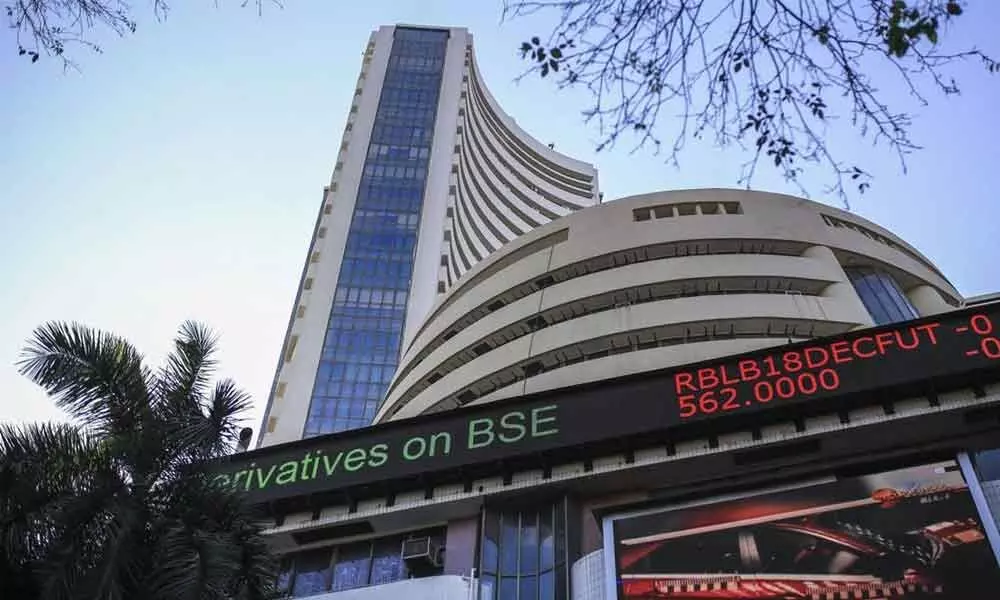Delta variant scare may spur profit booking

Remain bullish, play in that direction
FIIs have been investing aggressively in debt because of the rising spread between the bond yields in US and India
Spurred by GDP & GST collections data, renewed FII buying and positive global cues; the market had a historic week driving the BSE Sensex beyond 58,000 and the NSE Nifty above 17,300 mark for the first time.
The Sensex climbed 2,005.23 points, or 3.57 percent, to close at 58,129.95, while the Nifty jumped 618.40 points, or 3.70 percent, to 17,323.60. Exuberant broader market outperformed frontliners with the Nifty Midcap index rising nearly five percent and Smallcap index up four per cent during the week. After couple of weeks of selling, FIIs have net bought Rs6,867.73 crore worth of shares in the week ended.
The momentum in the market and the fear of missing the momentum might have brought FIIs back to equity in August say observers. However, it is pertinent to observe that FIIs have been investing aggressively in debt because of the rising spread between the bond yields in US and India.
The US 10-year is below 1.30 per cent and the Indian 10-year has risen above 6.2 per cent. Improved macroeconomic data supported rupee and the Indian rupee appreciated to 73 against US dollar, from 73.47 on week-on-week basis. Barring the month of June, the GST collection- often considered a barometer for consumption across sectors- has been above the Rs1 lakh crore-mark during the past 12 months.
Near term direction of the market will be dictated by global cues, news flow on Covid, crude oil prices and macroeconomic data like IIP, deposits and bank loan growth and others. Experts expect the growth in industrial output to be in double digits on a low base in the year-ago period and easing restrictions by states in India leading to an increase in economic activity.
The widespread delta variant scare across the globe may lead to some profit booking in the equity market as the scare may lead to concerns over global economic recovery. The market will remain shut on September 10 for Ganesh Chaturthi.
Heard on the Street: Bull markets give, and they take away. One of the most valuable assets erased by this bull market is the distinction between risk taking and risk seeking. A long bull market goads many investors into taking voluntary risks.
They seek bets they don't have to make. That isn't so surprising: The Nifty has closed at new all-time highs several times so far this year, making it seem almost as if the market will never go down again. And people often take more risk when the environment around them feels less risky.
The epic recovery from the Covid crash of early 2020 has reinforced the sense that markets are safer now. After that 34 per cent collapse, stocks hit new highs again only few months later. To stay out of trouble, ask yourself whether you are taking risks you don't need to.
Several stocks are up 25 to 200 per cent so far in 2021, while interest rates have been flat. Even if your target is a conservative 50/50 mix of stocks and other asset classes, the bull market has probably bumped you to 75 per cent stocks and 25 per cent other asset classes.
Without even taking any action, you've taken on extra risk. To get back to your target, sell some stock, buy other asset classes or both. Also ask: Is this a risk I need to take? Imagine making 10 times your money on an investment.
How would your life be different? If your answer is a shrug, then the risk isn't essential. Now, imagine losing everything. Is the trade worth making at all? Finally, ask whether it's a risk you understand.
Who's on the other side of this trade, and why are they willing to let you make money? In a severe bear market, you're often trading with someone who has to get out or go broke so you may have the advantage.
F&O/sector watch
Nifty scaled to record highs in the week gone by and closed above 17,300 mark for the first time. Hectic speculation in new entrants in F&O segment kept derivatives segment buzzing.
On option front, maximum Put Open Interest (OI) was seen at 17,000 followed by 17200 & 17100 strikes, while maximum Call OI was seen at 18,000 followed by 17500 & 17300 strikes. Call writing was seen at 18,000 then 17,300 &17900 strikes with unwinding at 17,200 and 17,100 strikes while Put writing was seen at 17,300 then 17,200 & 17,000 strikes.
Currently, ATM 17200 and 17000 strikes are holding significant Open Interest and one should trade positive above these levels. Implied Volatility (IV) of Calls closed at 11.55 per cent, while Put options closed at 12.42 per cent. The Nifty VIX for the week closed at 14.24 per cent.
Steel industry's consolidated borrowing has plunged to a nine-year low. The production cost of steel companies is expected to come down by about $50-55 tonne, partly compensating for the cost increases emanating from costlier coking coal purchases.
Use declines to buy Tata Steel, Sail and JSW Steel. Prices of aluminium — widely used in aerospace applications, packaging, automobiles and railroad cars and as a construction material —hit a decade-high of $2,720 a tonne during the week ended. Stay invested in Hindalco and Nalco for further gains.
Another set of 8 stocks-Abbott India, Crompton Greaves Consumer Electricals, Dalmia Bharat, Delta Corp, India Cements, JK Cement, Oberoi Realty and Persistent Systems will be in F&O from October 1.
Stock futures looking good are BPCL, Indraprastha Gas, L&T, Kotak Bank, RIL, and Pidilite. Stock futures looking weak are Coromandel, Sun TV, AU Bank, Escorts and M&M.
(The author is a stock market expert. He is former vice chairman of AP Planning Board)




